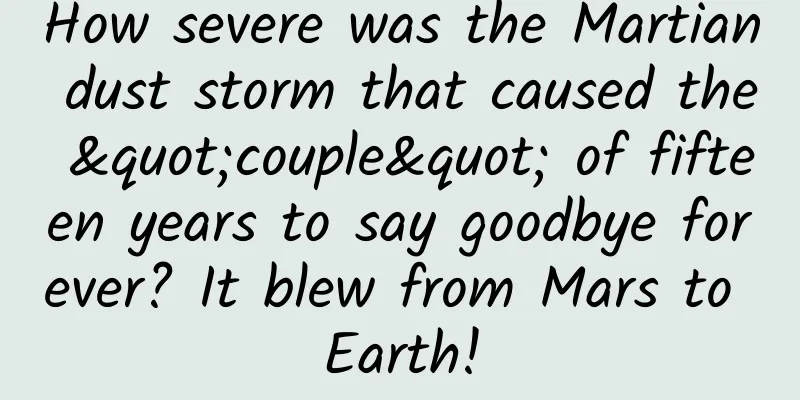How severe was the Martian dust storm that caused the "couple" of fifteen years to say goodbye forever? It blew from Mars to Earth!

|
Introduction: Have we ever thought that a grain of sand can fly to a place 55 million kilometers or even 400 million kilometers away? If you see this grain of sand coming from thousands of miles away with your own eyes, you will definitely be deeply touched and feel from the bottom of your heart that "I have never seen such a thing before". You will never guess that the reason why a grain of sand can be sent to the earth light years away is actually the Martian sandstorm. Let us explore together how powerful the Martian sandstorm is. Recently, NASA's Juno probe unexpectedly discovered a strange phenomenon: dust blown from Mars was moving rapidly towards the inner solar system, and the Earth was not spared, and some of it fell on the Earth. NASA scientists first discovered some unidentified particle flows while observing the sky over Juneau, the capital of Alaska, and thought they were a fuel leak from the Juno probe. The Juno probe was launched by the United States in 2011. After entering Jupiter's orbit in 2016, it began to orbit Jupiter to collect data about the largest planet in the solar system. Humans have never observed this giant in the solar system so closely before. On December 21, 2018, NASA announced that the Juno probe had completed 16 orbiting missions and sent back many recently taken photos of Jupiter's surface, allowing people to clearly see the appearance of this strange but beautiful planet. It's amazing that the Jupiter probe actually received dust from Mars. A careful analysis revealed that they were fine sand flows that fell from the probe's solar panels. NASA's document announcing the discovery said self-deprecatingly, "This expensive solar panel has become the largest and most sensitive dust probe ever built." The study, published March 9 in the Journal of Geophysical Research: Planets, used a camera on the Juno probe to track the distribution and paths of these dust storms and found that they actually came from Mars, and some of them also entered the Earth's atmosphere. The dust continues to accumulate on the probe's solar panels, and the sand leaks out when it is "full". Jack Connerney, chief researcher at NASA's Goddard Space Flight Center, said that although the sand is fine and light, it is large in quantity and fast in speed, hitting the solar panels at a speed of 16,000 kilometers per hour, which is wearing out the probe at any time. Fortunately, the solar panels of the probe are strong enough. Once the sandstorms on Mars start, they can last for a long time. So, what exactly do sandstorms on Mars look like? (1) The wind speed is unimaginably high Mars is the fourth planet from the sun. To the naked eye, it is a bright red star that catches the eye. The average temperature on Mars is -23℃, the atmosphere is thin, and there is very little water. The dry surface of Mars is covered with red soil and rocks. Mars has an unimaginable storm every year. According to the China Science Expo website, a force 17 wind on Earth is equivalent to a super typhoon, with a wind speed of more than 60 meters per second, while the wind speed on Mars is as high as 180 meters per second, three times that on Earth. Typhoon Earth Dust Storm Mars Dust Storm (2) Storms can sweep across the entire planet Martian dust storms can form spires 80 km high, and such storms are strong enough to drain water reservoirs on the Martian surface. The two studies were based on Martian weather data from 2018, when a sky-blocking dust storm swept across the Red Planet, causing an unexpected mission termination for NASA's Opportunity rover. The researchers observed huge dust towers in the storm, with a width of nearly Rhode Island and a height of 50 miles (80 kilometers), sending gas vapor and dust particles into the Martian atmosphere. The researchers pointed out that these towers could release water vapor from the surface of Mars into the upper atmosphere of Mars, where strong solar radiation could cause the water vapor to separate from the dust particles. Scientists say that Mars experiences global storms of these huge dust tower structures every ten years or so. Nicholas Hanvens, a scientist at Hampton University, said: Normally, this dust falls to the surface of Mars in about a day, but during global storms, the dust tower structures will last for several weeks. Dust towers are like "space elevators". Observers can see that they transport large amounts of Martian surface material into the Martian atmosphere. Previous research work by Hanwens has shown that Martian dust storms can bring water vapor and dust particles into the upper atmosphere of Mars, which would explain the periodic appearance of small white clouds on the surface of Mars. Scientists previously knew that there were many dust clouds surrounding the sun, and speculated that they came from distant asteroids and slowly leaked into the inner solar system. (3) Why are Martian dust storms so severe? Why can such a large dust storm form on Mars? From a scientific point of view, there is still no conclusion. However, Mars and Earth have similarities, and some scientists have conducted analogical analysis. Like Earth, the seasons on Mars are caused by orbiting the sun. But the eccentricity of Mars' orbit is higher than that of Earth, and Mars' orbit around the sun is not as round as Earth's. According to NASA, when Mars reaches the perihelion of its orbit, it will become significantly hotter, which is equivalent to the summer in the southern hemisphere of Mars. At this time, the sun's heating effect on the surface of Mars is relatively large, hot air rises, dust is raised, dust storms begin to form, and slowly expand. (4) Was Opportunity blown apart? Do you remember the beginning scene of the movie "The Martian"? A strong dust storm hit Mars, forcing the astronauts who came to explore to evacuate urgently. At this time, the spacecraft tilted more and more seriously, and even had to rely on burning fuel to maintain balance. However, due to the low density of the atmosphere on the surface of Mars, dust storms that can put astronauts in danger are impossible to actually happen on Mars. For example, if you want to fly a kite on Mars, you need a much higher wind speed than on Earth to blow it into the sky. The biggest difference between the dust storms on Earth and Mars is that the atmospheric pressure on Mars is very small and the atmosphere is thin. So even if the same object is blown at the same wind speed, the intensity is different. Therefore, there are indeed dust storms on Mars, but they are not like those shown in the movie "The Martian". Even the largest global dust storm on Mars cannot blow over or tear up major machinery and equipment, so NASA can still find the "Opportunity", but it will never wake it up. (5) Martian dust storms are not harmless Although the destructive power of Martian dust storms is not strong, the dust particles on Mars are very small and have micro-static electricity. They will attach to the surface of any object and even drill into the inside of machinery and equipment, causing the machine to malfunction and not operate normally. Moreover, dust coverage is also a big problem for solar panels. Even a very small dust storm may roll up a lot of dust and cover the panels. Without enough sunlight directly shining on the solar panels, it will not be able to provide sufficient electricity. However, when solar radiation reaches the surface of Mars, it will heat the air on the surface of Mars again, while the air away from the surface is still relatively cold. The convection of the two kinds of cold and hot air together may raise the dust again, which may cause a larger dust storm. When a global dust storm comes, equipment such as rovers or landers working on the surface of Mars need to wait quietly until the dust storm ends. As early as the evening of February 12, 2019, a song "We Will Meet Again" sounded at the control center of the National Aeronautics and Space Administration (NASA). This was the last contact between NASA and the "Opportunity" Mars rover, which had been out of contact for 8 months, but there was no response. Back to the end of May 2018. A severe sandstorm broke out on Mars, affecting an area equivalent to 1/4 of the surface area of Mars. On June 10, 2018, Opportunity sent its last message to Earth, indicating that its battery was low. Scientists speculated that this was because a huge amount of dust blocked the sunlight, causing the solar-powered Opportunity system to automatically enter hibernation. After that, NASA continued to try to contact Opportunity, "calling" it tens of thousands of times, and hoped that after the sandstorm subsided, Opportunity would be able to break through the siege and restart like it had encountered many difficulties before. However, once the dust storm on Mars starts, it is "long-lasting". The Opportunity rover, which has been swallowed by the dust storm for 8 months, is still missing. Netizens have expressed their condolences on social media. On February 13, 2019, NASA officially announced that the Opportunity Mars rover mission had ended and it had retired successfully. Opportunity has been exploring Mars for 15 years, traveling more than 45 kilometers and sending back nearly 220,000 photos, including 15 360-degree color panoramas of Mars. It found hematite, which formed in a water environment; it found evidence of water on Mars and an environment that could have been suitable for the survival of microorganisms. The last "complete" selfie of Opportunity before it lost contact in 2018 became its swan song. How sad it is, and it is unbearable to imagine how helpless Opportunity was in the sandstorm that covered the sky. It was after the Opportunity rover experienced a Martian dust storm that "suffocated" its solar panels that it became difficult to wake up again, so NASA was forced to announce that it would give up on waking up the Opportunity rover. NASA said that with the discovery of the Juno probe, scientists have a better understanding of the source and path of these cosmic dust, which will help plan the routes of future exploration projects to avoid these dust storms as much as possible. Exploring Mars is for our Earth. Landing on Mars is the dream of all mankind. However, the thin atmosphere of Mars, huge sandstorms, complex terrain and unpredictable wind direction, these unknown environments are not difficult for the Tianwen-1 orbiter and the Zhurong probe, who are like countless resolute, courageous and lovely scientific research staff fighting on the front line of aerospace. As of July 30, 2021, the Zhurong rover, which started off-road, has worked on the surface of Mars for 75 Martian days and traveled a total of 708 meters. The orbiter has been in orbit for 372 days, and the two devices are in good condition and all systems are working normally. With the same roots and the same heart, each picture conveys true feelings. I hope this pair of "lovers" from China can stay together forever, never lose contact, and their love will never change! |
>>: In the world created by “screens”, the word “natural” is becoming less and less common?
Recommend
Double Eleven pre-sales exceeded 20 billion: How did Li Jiaqi and Wei Ya create huge GMV?
On the first day of Double Eleven pre-sale, Li Ji...
Latest warning! Guangzhou is facing the strongest "water splashing mode" this year, please be sure to take precautions
Latest warning! Guangzhou welcomes the heaviest r...
If a tool app wants to transform, what should the operators do?
Meitu was cashed out by early-stage investment in...
Will robot sex become a reality within 10 years?
Robots will gradually move from science fiction, ...
With these tools, you can easily create high-conversion landing pages even if you don’t know design or code!
The landing page is an important part of relation...
How can holiday marketing be less “greasy”?
It’s the annual “buy, sell, buy” Double 11 shoppi...
The 9 most effective free fission customer acquisition, retention and monetization methods in 2020!
Affected by the epidemic, many companies have tra...
The top five marketing trends in 2018, you must know the third one!
In the past 2017, the mobile marketing market has...
A major benefit for information flow advertising, “Super” Fans Pass is coming! Attached effect case
I believe that friends in the channel circle have...
The underlying logic of event planning and promotion!
When it comes to event planning, what everyone th...
8 ways to make your app icon stand out
The app icon plays a very important role in the c...
App promotion: 15 rogue promotion methods should be used with caution!
Rogue promotion methods are methods that some man...
What secrets are hidden in the background data of public accounts that you don’t know about?
Is it true that every time you look at the backen...




![[National Cancer Prevention and Treatment Week] How to prevent and treat these 5 common infections after colorectal cancer surgery? This article will teach you!](/upload/images/67f1fa8b90508.webp)




